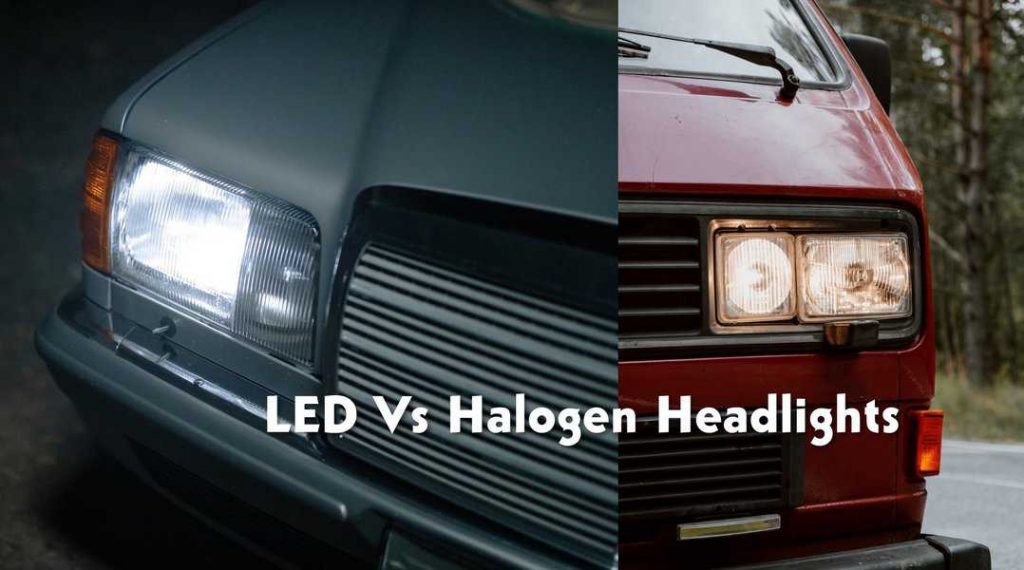The LED vs halogen headlights comparison has been going on for years.
It doesn’t seem to slow down or stop soon since the automobile industry welcomes new vehicle owners every day.
If you have always wanted to know the attributes/qualities that differentiate these two bulbs.
This guide provides comprehensive details anyone interested in the topic may need or find educating and enlightening.
To give comprehensive reports about the halogen vs LED headlights dialogue/discussion among interested individuals.
We have divided the article into different sections, highlighting various focus points for unrivaled clarity.
What is Halogen Headlight?
Halogen headlights are designed to shine across the path of drivers/vehicle owners when driving at night.
These headlights are referred to/regarded as incandescent lights.
The light is produced from a bulb with the aid of a filament inside it. The filament is known as tungsten.
Once the filament comes in contact with electric current, it charges or heats up as the case may be, leading to light production.
Halogen headlights enjoyed extended years of patronage and favoritism due to two factors: low-cost of production and ease of replacement.
These factors still play an integral part in their existence to date.
What is LED Headlight?
Since its introduction, LEDs have enjoyed an excellent level of adoption and preference in the automobile industry, especially in premium designs, positioning them above halogen headlights by a wide margin.
LED headlights are designed to perform a similar function/duty as halogen lights. However, their mode of operation differs.
Instead of the tungsten filament (for halogen headlights), LED headlights to generate their lights through the help of a diode, also known as a semiconductor.
Once the diode receives or comes in contact with an electric charge, it produces/delivers brighter light output.
Impressively, the heat that is generated is effectively controlled/minimized.
Today, LEDs have become the preferred replacement choice among old and new vehicle owners due to several benefits discussed/highlighted in the halogen headlights vs LED comparison section.
LED Vs Halogen Headlights: What Are Their Key Differences?
This section gives a comprehensive breakdown of LED headlights vs halogen by considering critical performance components/parameters.
01. Brightness
When it comes to the clarity/intensity of the light output generated/delivered by LED and halogen headlights, the former (LED) comes on top by a considerable margin.
LEDs are designed to offer about thrice the brightness level halogen headlights deliver.
02. Spread
LEDs offer brighter/even light output or intensity, ensuring the path/road is adequately covered for improved clarity and vision.
LED headlights to illuminate and spread across the road over a long range so that the driver can see the objects on the road from a few meters away.
03. Color
The brightness, range, or spread offered by LED headlights is supported by their clear/white light color.
On the other hand, the halogen headlights offer/produce yellow-hued light, which is mostly restricted to the front of the vehicle,
04. Price
Just as the famous saying, “all good things come at a price,” the LED headlights are not in any way different.
At the point of purchase, LEDs are more expensive than halogen lights.
However, considering the long-term cost implication, the price is economical/reasonable since they last longer (at least three times longer than halogen).
05. Safety
When it comes to safety on the road at night, especially when driving across rural areas where there is an absence of street/road lights, LEDs are simply the favorite.
The clear/bright light output ensures you can see road signs, perceive the road conditions, and get a better view of the things happening in your surroundings.
Nevertheless, halogen headlights have proven to be a top option in extreme weather conditions.
Compared to LEDs, halogen lights cause lower/lesser glare since they are typically known to deliver a warmer glow. Individuals who live in extreme climates with a preference for LED.
Settling for designs that produce warmer light guarantees reduced glare during bad weather situations, especially when it’s foggy.
06. Efficiency
LEDs are designed to offer a higher lighting performance than halogen while keeping energy consumption low.
Basically, the improved light brightness is achieved using less amount of energy. On average, LEDs offer up to ninety percent (90%) efficiency than halogen lights.
07. Reliability
The LEDs still come up on top when it comes to reliability. These headlights are designed to respond faster to command/operation.
They come up instantly, provided there is sufficient/adequate current. Basically, LEDs illuminate faster, eliminating the delay that occurs in halogen.
08. Lifespan
LEDs are ahead when it comes to longevity or extended performance.
The efficient heat control mechanism/system they are equipped with (heat sink or cooling fan) contributes significantly to increased/extended lifespan.
Depending on the construction quality of the headlights, on average, halogen can last up to a thousand hours (1,000 hr.).
In comparison, LEDs can keep illuminating the driver’s path for as long as twenty thousand hours (20,000 hr.).
09. Availability
Both bulbs are easily assessable or available for purchase.
Since they are both popular/common in several vehicles on the road (both new and old), getting a replacement when necessarily isn’t an issue.
However, since we are comparing these two designs, there must be a winner.
In that case, halogen can be classified as a more available option. Since it is a universal design, it is more likely to be available in any auto store around you.
10. Led & Halogen Headlights Distance
The LED light output travels faster and across a longer range than halogen.
When used across a short or long distance, LED headlights to offer a brighter illumination.
Not only that, the level of effectiveness associated with halogen lights drops at a faster rate compared to LEDs.
Halogen Vs LED Headlights: Which is Better?
Benefits
Halogen
- Halogen headlights are pocket-friendly, making them more affordable than LEDs
- Halogen headlights come in a simple design, aiding smoother/easier replacement
- They perform excellently in poor weather conditions since they do not cause excessive/unnecessary glare
- Readily available or accessible for purchase/replacement
- The light output/intensity is softer than LEDs, reducing interference with the vision of other drivers on the road
LED
- Illuminates speedily for improved effectiveness/efficiency
- Long-lasting, illuminating the roads over several hours/years of use
- The smaller bulb design encourages creativity when it comes to design
- Fancy/attractive lighting
- Doesn’t produce/generate much heat
- Energy usage/consumption is low, making a huge difference in electric vehicles
- LEDs are not difficult to find or purchase in case of replacement or upgrade
- The light pattern LEDs deliver on the road is adequate/sufficient for improved coverage. Thus, keeping the driver informed about the road situations, most especially activities/objects ahead and within the surroundings
Common Problems of Halogen
- Slower illumination pattern, compared to LEDs
- Energy efficiency is low
- Clarity, coverage, and brightness are lower compared to LEDs
- When it comes to LED vs halogen headlights distance, halogen offers a lower range across short and long distances
- The lifespan is shorter compared to LED. As a result, a replacement will be needed or necessary from time to time
On average, a vehicle owner who has halogen headlights may have to replace the bulbs once every 500-1,000 hours of operation.
- Consumes a large amount of energy, making them econ-unfriendly
- The filaments are known for their low/reduced durability, which is evident in how soon/fast they get damaged or break
Common Problems of LED
- The setup isn’t as smooth/straightforward as halogen due to the bulky design (heat sink or cooling fan inclusion)
- LEDs are not suitable in extreme weather conditions (especially when it’s foggy) due to the severe glare they cause
- LEDs are designed to illuminate across several/multiple directions. If a replacement is conducted and not done appropriately. It could lead to a high reduction rate in performance, affecting the activities of other road users
Why Are Halogen Headlights Still So Extensively Used?
When you watch vehicles on the road closely, it is evident that most of them still have halogen headlights installed.
Most people ask why, considering the level of efficiency that LED offers.
Considering the continuous adoption, it is evident that halogen headlights will be around for the foreseeable future.
This can be linked/connected to some of the distinct features/attributes they naturally possess.
Halogen headlights do not cost much to manufacture, application/replacement is easier, and the operation is relatively universal.
When the halogen bulb fades/burns out, a replacement unit can be picked up at most auto stores.
Is Upgrading To LED headlights Always a Smart Decision?
Yes, it is, considering the performance upgrade it delivers to your vehicle’s headlights. Especially if you travel a lot at night.
However, if anyone desires to go ahead with an upgrade (replacing halogen headlights with an aftermarket LED design). The process must be followed appropriately.
While the replacement process is quite similar, making the knowledge/experience acquired through halogen replacement valid or applicable.
The LED headlights installation process requires more time and patience.
Since the setup differs, the installer must understand how each installation component should be attached, placed, or positioned for best outcomes.
Are There Any Other Alternatives to LED and Halogen Headlights?
Besides the two headlights designs that have been up for discussion so far in this guide, another quite popular option is the HID (high-intensity discharge).
Now to the properties and setup. Like the other two we have discussed so far, the HID headlight uses a light bulb.
Within/inside the bulb are two (2) electrodes housed in a glass-like compartment.
Pros
- HID headlights offer a better level of clarity/brightness than halogen headlights
- Energy usage/consumption is low
- Light intensity spreads across a long range, compared to halogen
- Ensures your vehicle becomes more visible to other drivers on the road
- The installation is effortless
- HID headlights are affordable compared to LEDs
Cons
- Not a suitable choice in foggy weather conditions
- Costlier than halogen headlights
Why Should Pick HID Over LED or Halogen
HID comes in between LED and halogen. It offers lower/lesser results than LED but higher outcomes than halogen when it comes to efficiency and performance.
If anyone desires improved performance/efficiency than the regular headlights offer but can’t afford to settle for LED headlights due to their high price. HID headlights make a perfect alternative.
Halogen Headlights Vs LED: Which Type of Headlight Should You Choose?
a) Driving Style & Price
The choice of headlights to settle for depends on the driving needs.
For individuals who travel at night from time to time, investing in a quality light like the LED goes a long way in making the trip worthwhile, especially when it comes to safety and protection.
However, if driving at night isn’t in your books, especially for individuals who return from work before sunset.
Considering how expensive it is, investing in LED headlights may not be a sound investment decision.
In that case, halogen headlights may be a great option. Well, if the price of LEDs isn’t an issue, why not?
b) Headlight Assembly (Projector Vs Reflector)
For vehicles with reflector headlights, performing an LED upgrade may require the installer to replace/upgrade the reflector bowl for best performance.
Failure to do so could affect the vision of other drivers on the road.
If you are really determined about enjoying/experiencing the best light performance on the road. Nothing is too much to achieve this result.
Frequently Asked Questions
When Should The Headlights Be Replaced?
Do not wait until the bulbs stop working before a replacement plan kicks in motion.
Get a new headlight installed once the light output dims or stops performing as usual.
How Do I Ensure The Best Performance?
For optimum performance, ensure all the headlights are replaced simultaneously.
It doesn’t matter if other bulbs are in good working condition.
The ideal thing is to have all replaced for consistency and reliable performance.
What Brands of Vehicle Use Halogen Headlights
Some popular vehicle brands/manufacturers still design their headlights using halogen.
These brands include Honda (city, Jazz, HR-V and Civic), Toyota (Vios & Yaris), and Polo.
What Happens If The Heat Sink is Not Positioned Appropriately?
If the heat sink is not correctly positioned (when placed directly at rubberized components within the engine bay).
It could lead to burn/melt, resulting in an expensive replacement of the affected parts.
How Do I Choose an Ideal LED Headlight?
It is essential to state that LEDs are available in various options/designs.
When choosing a design to buy, go for a solid option that supports effortless installation and delivers the performance that complements driving needs.
Final Thoughts
Irrespective of why the LED vs halogen headlights comparison is of great interest to you. Whatever the case may be.
We hope everyone achieves or gets a comprehensive understanding of these headlights, ensuring decisions are made based on knowledge rather than emotions.
If you are looking for a reliable bulb replacement and do not have a specific design of interest.
Going through the products, we have reviewed in this guide may provide the clarity needed to make the best decision.

Hello! My name is John Smith. I’m the creator of this website. Since childhood, I had a passion for cars and its mechanisms. So, I started working in the automotive industry when I just left school, and how I have over 10 years of experience in this industry. To make my experience alive through the content I started blogging through Lighting Sparkle. I hope that my experience through the content can help you a lot in making decisions and learning.

